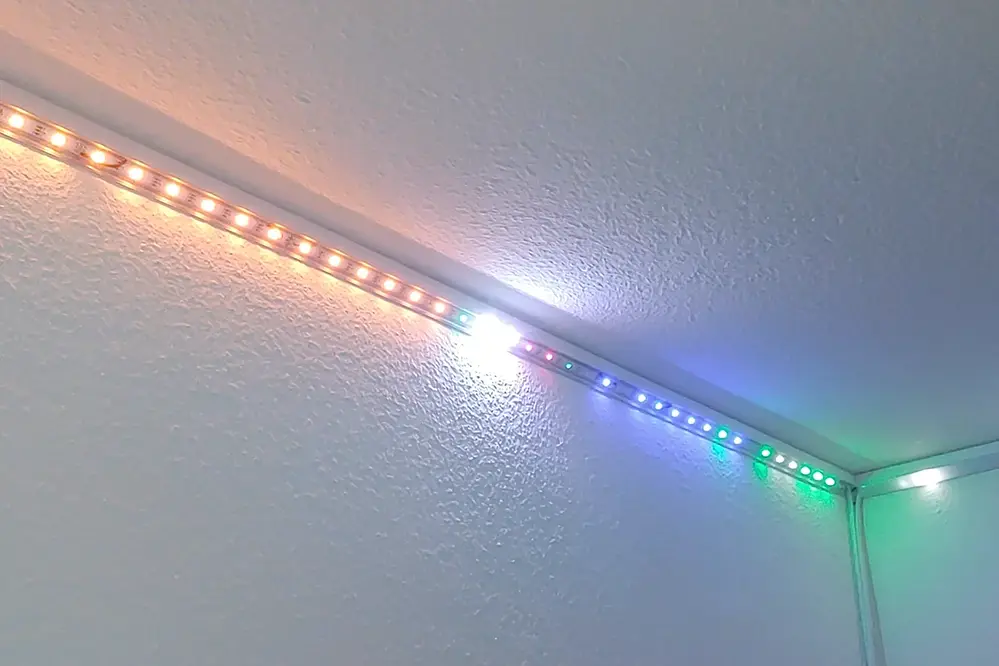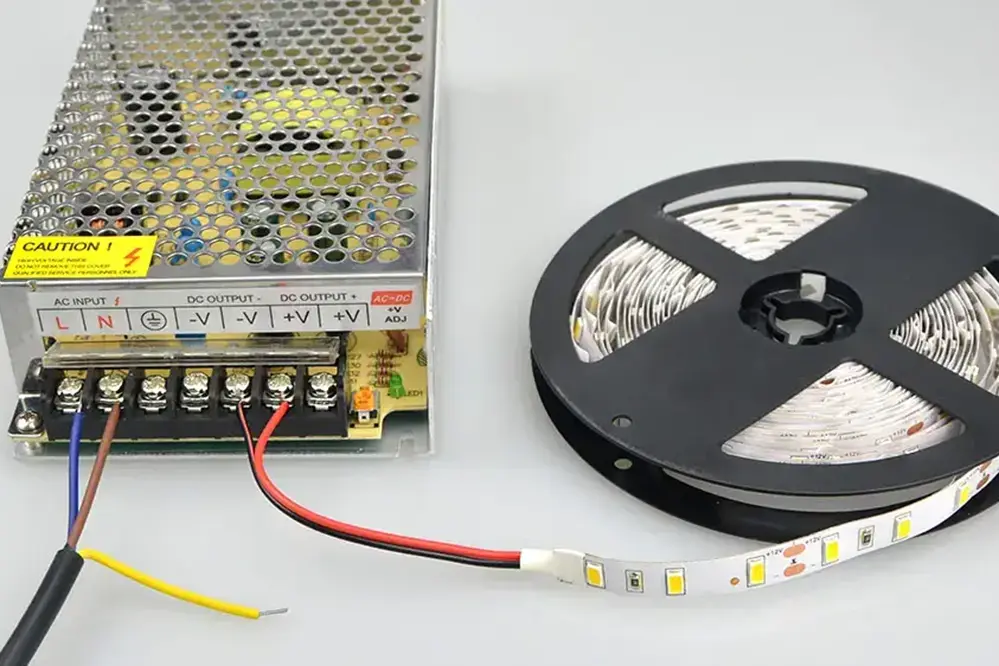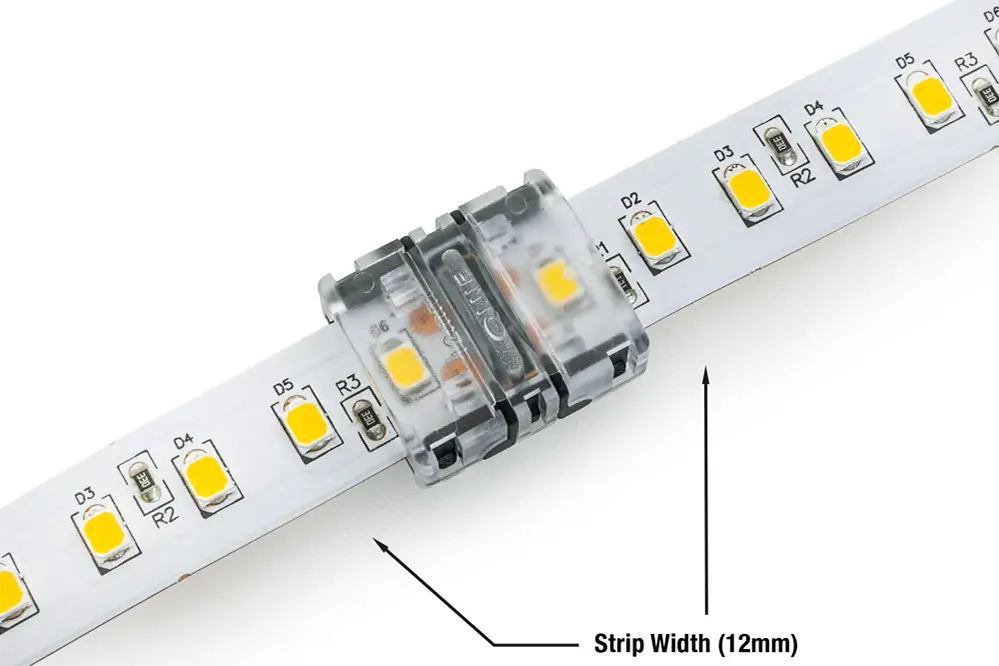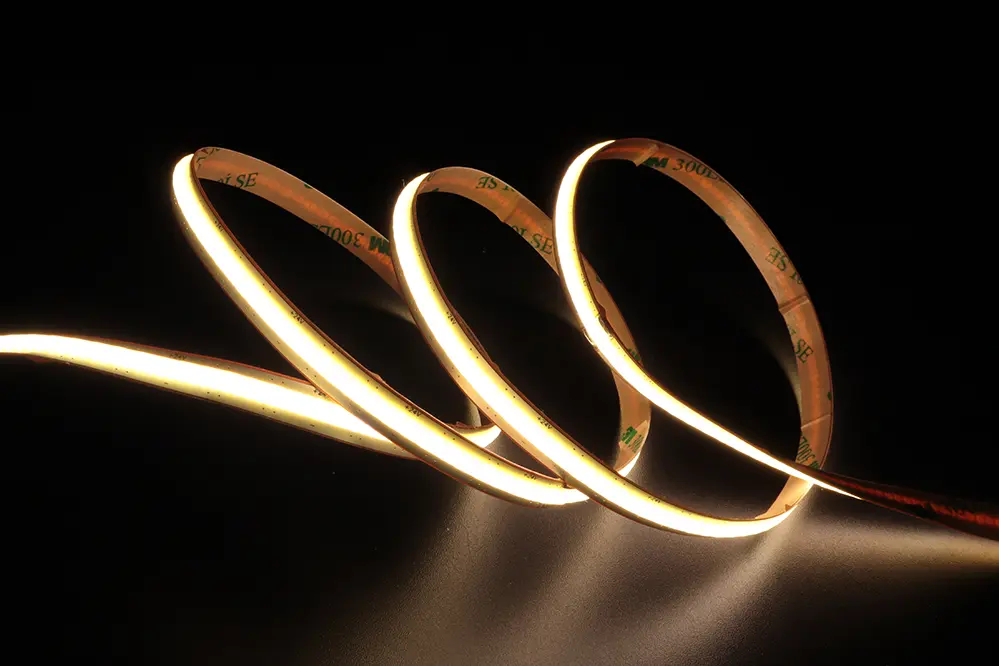Are flickering LED strips driving you up the wall? You’re not alone. Many people encounter this frustrating issue, often wondering if there’s a simple fix.
Flickering can stem from various causes, including voltage fluctuations and incompatible components, leading to widespread misconceptions about LED technology. Despite these challenges, solving flickering LED strips is not only possible but can also enhance the longevity and performance of your lighting setup.
In this article, we’ll explore the common causes of flickering, delve into the benefits of addressing these issues, and provide actionable solutions to restore your lighting’s stability.
By the end, you’ll be equipped with the knowledge to tackle flickering head-on, ensuring your LED strips shine brightly and consistently.
Identify Causes of Flickering

Flickering LED strips can frustrate even the most seasoned DIY enthusiasts. Understanding why LED strips flicker is essential to resolving the issue.
Identifying the root cause helps ensure a long-term solution.
Common culprits of flickering include insufficient power supply, voltage fluctuations, or a faulty driver. These can lead to a mismatch between the power requirements of the LED strips and the capability of the power source, causing intermittent illumination.
Another frequent offender is the use of incompatible dimmers, which can interfere with the dimming function and exacerbate flickering issues. If a dimmer is incompatible with LED technology, it can cause variations in current, ultimately leading to flickering. To address this, ensure you’re using “LED-friendly” dimmers specifically designed for optimal compatibility.
Check Power Supply

First and foremost, examining your power supply is paramount when addressing flickering LED strips. It is a crucial step to diagnose the problem.
One common issue could be an overloaded power source. If your LED strip is demanding more power than what is available, it can lead to inconsistent lighting. Ensure that your power supply has adequate wattage to support your LED strips and any additional connected components.
Sometimes, the culprit might be a failing power adapter. Over time, power adapters can degrade, leading to inefficient energy transfer. Try replacing the adapter with a new one that meets the necessary voltage and current ratings to see if flickering persists.
Also, examine the connection between the power supply and the LED strip. Secure, tight connections between these points are vital to prevent power loss or fluctuations, which could contribute to flickering. Occasionally, a simple reconnection is all it takes to restore smooth operation.
In conclusion, scrutinizing your power supply is essential to solving flickering LED strips.
Inspect LED Strip Connections

Inspecting LED strip connections is pivotal in addressing flickering issues. Loose or improper connections, particularly poor connections, can often be the hidden culprit behind instability.
Recent years, electrical sciences, a foundational subject within engineering, underscored how electrical systems rely on solid connections to function optimally, which means that reconnecting and securing loose connections might be the solution you need.
So, it’s not too much trouble to check whether there’s something’s amiss by taking a systematic approach. Begin at the source of the connection and trace the LEDs to ensure each segment is fitted snugly and correctly. This guards against the risk of weakened contact.
Consider the makeup of the connectors used, ensuring that all materials are compatible and in prime condition, as inefficient connectors won’t make the grade for top-tier performance, causing potential disruptions or inconsistencies.
Resolving flickering LED strips starts with a genuine inspection of every connection to verify they meet expected standards.
Evaluate Dimmer Compatibility
Determining the compatibility of your dimmer with LED strips can be crucial in resolving flickering issues. Many older dimmers were designed for incandescent bulbs and may not work efficiently with LEDs. In 2016, advancements in lighting technology brought a plethora of dimmer options that better cater to the unique needs of LED strips, with fine-tuned controls that avoid flickering and optimize performance.
If your existing dimmer isn’t LED-compatible, it might lack the ability to provide a seamless flow of electrical current, a necessity for modern LED technology. It’s recommended to consult the LED strip’s manual or manufacturer’s guidelines to ensure your dimmer is suitable. Simply replacing an incompatible dimmer with an LED-compatible model can often solve flickering LED strips effectively.
The latest range of LED-compatible dimmers offers not only basic functionality but advanced features such as smart connectivity and programmable sequences. Taking advantage of these innovations can significantly enhance your lighting experience. Evaluate whether your current setup could benefit from such upgrades, particularly if flickering persists despite steps taken to secure connections.
Remember, a compatible dimmer doesn’t just eliminate flicker—it can transform your entire space with precise light control, adapting effortlessly to your mood and activities. Investing in a high-quality, LED-compatible dimmer is an investment in both style and functionality.
With diligent evaluation of dimmer compatibility, you’re one step closer to enjoying flicker-free, atmospheric lighting in your home or workplace.
Test with a Different Controller
When your LED strips continue to flicker despite efforts, consider trying a different controller to address potential underlying issues effectively.
Controllers are pivotal in managing the LED system’s output and performance. A defective controller could contribute to flicker problems.
Swapping controllers allows you to pinpoint if the current device might be the source of malfunction. It’s a sensible troubleshooting step.
Opt for controllers with robust circuit algorithms to ensure optimal performance and reduce flickering. Ensure compatibility with your LED configuration.
By testing alternate controllers, you gain insights into possible upgrades that might minimize issues, guiding you toward solutions that maintain steady illumination.
Ultimately, the right controller not only solves flickering LED strips but also enriches your lighting control, elevating your environment.
Examine Voltage and Wiring
Ensuring the LED strips are receiving the correct voltage is imperative for steady illumination, and this check should be your first consideration.
Sometimes, the issue lies in voltage inconsistency, which causes LED strips to experience visible and invisible flicker.
This can be examined by using a multi-meter to assess voltage readings against the required specifications. A mismatch between expected and actual voltage indicates a need to adjust or upgrade your power supply to stabilize lighting performance, ultimately ensuring peace of mind.
Additionally, improper wiring connections can be a source of flickering. In this instance, carefully inspect all wiring for loose or corroded connections. If discovered, it is advisable to meticulously secure or replace any affected wiring components. Such attentiveness ensures a continuous flow of electricity, allowing your LED strips to shine brilliantly, free from interruptions.
Replace Faulty Components
Occasionally, flickering LED strips result from malfunctioning parts, demanding thorough evaluation and replacement of these components.
To solve flickering LED strips, focus on checking the LED drivers and dimmers, as these are prone to failures that impede consistent lighting. Should issues be identified, replacing these devices can dramatically improve performance and eliminate flickering, ensuring your lighting system operates flawlessly.
The terms “flicker-free” and “non-flicker” are often synonymous and indicate components designed for the desired stability.
Swap Out Strip Sections
Flickering LED strips, while occasionally daunting, can be swiftly mitigated with strategic section replacements. This approach ensures continuous illumination without the hassle of full system overhauls.
Replacing the malfunctioning sections of a strip with “fresh links” not only revitalizes your display but can be a quick fix for underlying issues. This tactic ensures restored harmony and visual appeal.
Replacing faulty sections can boost energy efficiency, prolonging the lifespan of your LED strips effectively.
An organized method: to identify the sections of the strip that are causing noticeable interruptions, leverage a multimeter or continuity tester, isolating the defective parts for replacement. This action secures not just illumination but also longevity for your vibrant displays.
Use Stable Power Sources
When aiming to solve flickering LED strips, securing your power source is a crucial first step.
An unwavering power supply provides a consistent voltage necessary for LED strips, ensuring that fluctuations, which can instigate flickering, are minimized. As electricity flows through your system, any instability in the power source can lead to inconsistencies in the light output, manifesting as flickering. Thus, investing in a high-quality, stable power source is essential for smooth operational performance.
Additionally, you might encounter voltage drops if a power supply is not designed to support the LED strip’s requirements. To prevent this, double-check that the power supply matches the needed voltage and wattage ratings of your LED setup, ensuring that it can handle the demand.
Finally, do not underestimate the significance of certified power sources that align with international standards for electronic devices. They offer extra reliability and adhere to rigorous safety regulations, assuring you that your LED strips are supported by a stable foundation. With robust and dependable power, your LED lighting will shine brilliantly, enhancing your environment and lifting your spirits.
Upgrade to Higher Quality Strips

Considering a transition to higher quality strips may be the decisive step towards solving flickering LED strips.
Recent years, renowned researchers, a choice notoriously synonymous with breakthrough innovation, noted that lower quality strips often lack the necessary components to stabilize light output, leading to performance fluctuations.
So, it’s no real surprise that their absence contributes to flickering and hence underscores the importance of acquiring strips designed for consistency. Such strips incorporate better components that efficiently alleviate any inconsistencies and enhance the vibrancy of the emitted light.
Investing in premium-grade strips also means opting for products that align with the demands of the 3, making them more energy-efficient, which further consolidates their superiority in solving flickering nuisances.
Upgrade your lighting setup and enjoy peace of mind; higher quality strips provide a luminous experience that stands the test of time.
Adjust Lighting Environment
Adapting the ambient lighting environment, a process of intentional adjustment, often pays dividends. Flickering issues can arise when LED strips interact negatively with other light sources, causing performance disruptions or a subtle power imbalance impacting their efficiency.
To explore the potential of a more harmonious setup, consider using a “lighting zone”. This is not just a matter of spatial arrangement but affects placement relative to other electronics. By rearranging and optimizing your light zones, you create a cohesive ambiance, mitigating instances where LED strips could otherwise falter. Practice this strategy, and you might find your lighting welfare transformed, revealing an unwavering illumination worth celebrating.
Control Ambient Light Levels
Controlling ambient light levels is crucial for reducing the flickering of LED strips, as they often react to other light sources in proximity.
Minimize conflicting lights and unnecessary shadows that could affect performance.
You should strive for consistent levels of ambient lighting throughout your space by using a variety of lighting solutions that maintain balance and harmony, whether it’s through dimmable lights, natural light optimization, or strategic use of curtains.
By thoughtfully managing light levels, you can ensure the LED strips thrive in an environment that promotes stability and consistency. This approach not only enhances the ambiance but also contributes to energy efficiency by avoiding “light clutter” that can overwhelm and confuse these sensitive lighting fixtures.
Consult Professional Assistance
If flickering LED strips persist, seeking professional guidance can save time, frustration, and potential missteps in solutions.
A certified lighting technician possesses a comprehensive understanding of intricate lighting systems, ensuring that your LED strips achieve their optimal performance. When self-diagnosis fails to yield results, these professionals navigate complex issues to provide clear, effective solutions. They employ advanced diagnostic tools that go beyond surface-level symptoms, thoroughly investigating and addressing underlying causes.
Moreover, specialists bring a wealth of experience in handling diverse electrical setups. By involving their expertise, you can avoid exacerbating problems that might not be immediately visible. With their help, you can ensure proper installation, quality materials, and even future advice for maintaining efficient LED lighting systems.
In conclusion, consulting professional assistance not only safeguards the integrity of your lighting systems but also optimizes their performance. Their expert input on flickering issues reinforces reliability and extends the lifespan of your fixtures. Ultimately, utilizing professional services cultivates an environment where your LED strips operate efficiently and consistently, contributing both to aesthetic appeal and practical lighting solutions.
Implement Regular Maintenance
Regular maintenance is crucial to resolve flickering issues.
Consistent inspections ensure that your LED strips function flawlessly. This simple practice not only keeps the LEDs performing at peak levels but also extends their longevity by catching potential issues before they manifest as visible problems. Ultimately, attention to detail is the key to maintaining the vibrancy of your lighting.
A structured schedule facilitates these checks efficiently.
Determine how often to conduct maintenance based on – not just the hours your LEDs spend shining bright – but also factors like humidity, temperature, and voltage fluctuations in the environment. These variables greatly influence LED longevity and performance.
Therefore, a proactive approach to maintenance synchronizes perfectly with the sophisticated prevention of problems, reflecting our commitment to effective solutions for LED flickering. By adopting these strategies, one can ensure that lighting remains both a beacon of inspiration and a prime example of technological harmony.
Conclusion
Embarking on the journey to solve flickering LED strips transforms challenges into opportunities for improvement, ensuring consistent and reliable lighting. By pairing meticulous care with effective troubleshooting, you can enhance both aesthetic and functional spaces. This systematic approach not only revives visual splendor but also protects your investment in quality illumination. Ultimately, addressing flickering issues showcases human ingenuity, turning challenges into opportunities for brilliance and innovation in LED lighting.
For those seeking expert assistance in resolving flickering LED strip issues, consider reaching out to Unitop, a leading Chinese manufacturer of LED strip lights and LED neon strips. With their extensive experience and commitment to quality, Unitop offers innovative solutions tailored to meet your lighting needs. Whether you’re enhancing a residential space or a commercial environment, their professional guidance ensures optimal performance and longevity for your LED installations. Contact Unitop to explore how their expertise can illuminate your world with precision and reliability.





